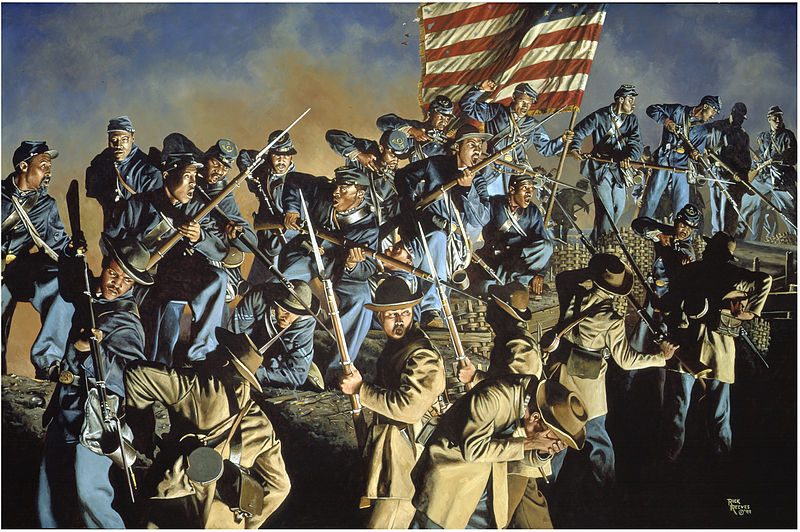You often hear about how the Civil War brought submarines, iron-clad ships, or the telegraph into play, but that’s not exactly true. While they are important innovations and their use in war was greatly beneficial during the War Between The States, they weren’t invented for or during the war, nor was the Civil War the first time or place they were used in war. It’s just the first time they were used in the United States.
Now if you want to know about true innovations of the Civil War, the ones that were invented for or were used in a new way during the war, here are the top ten:
10. Army ambulance corps
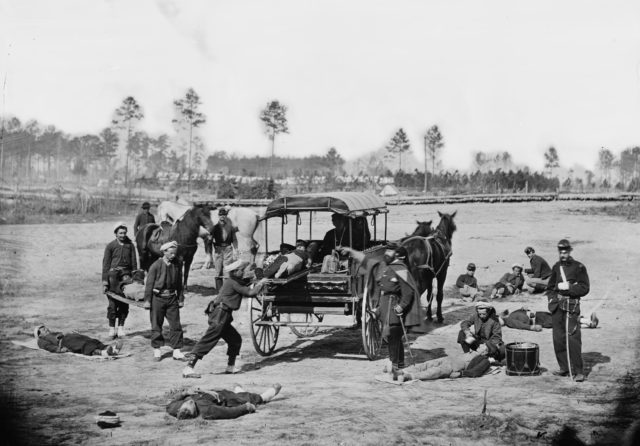
Before the Civil War, wounded men suffered on the field. Sometimes in agony for days and it was up to their own effort to survive until help arrived – if it ever did. At the Second Battle of Manassas, it took two weeks to retrieve the wounded from the battlefield and a solution was needed.
When Dr. Jonathan Letterman, the Father of Battlefield Medicine, was appointed a Major and the Medical Director of the Army in 1862, he revolutionized military medical procedures. Soldiers were trained to move the wounded on stretchers to the first of three stations, the Field Dressing Station where they were given immediate bandaging or tourniquets. They were then moved to the Field Hospital (in a nearby structure like a barn, school, or house) for surgery or other treatment, and finally, they were transported to an offsite, larger hospital for care.
This was the first time the concept of triage was used in a battlefield setting.
It worked. In comparison to the two weeks it took in Manassas, transporting the wounded at Antietam soldiers took only 24 hours.
9. Portable telegraph
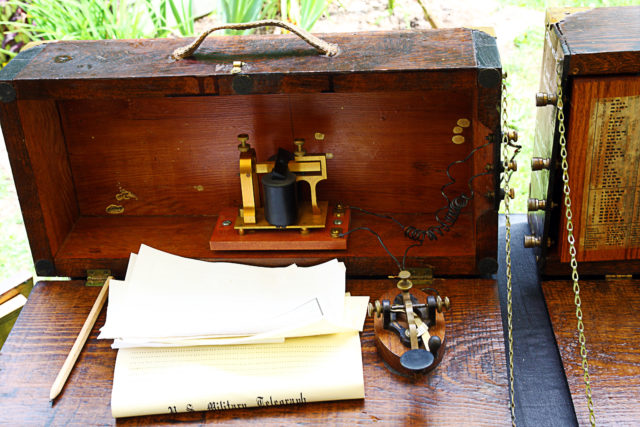
This includes two firsts. The first time telegraphs were portable, and the first time that spies used the telegraph to wreak havoc.
Lincoln was the first president to be able to communicate effectively during battles, and the Confederates soon took advantage of this as well – but from a different angle.
George A. “Lighting” Ellsworth, was a Canadian Morse code genius who had studied at the Morse school in Washington. Soon after meeting him in Kentucky, Brigadier General John Hunt Morgan knew Ellsworth would be a perfect candidate for his plan to use the telegraph as an instrument of espionage.
Ellsworth picked up the name “Lightning” after sending his messages knee deep in water during a lightning storm, and he escaped Union forces during the Battle of Buffington Island by swimming across the Ohio – holding onto his portable telegraph machine.
He was quick as lightning, escaping capture in Kentucky, working on an attempt to rescue Confederate POWs, and he is thought to have died an outlaw gunslinger in the Texas panhandle.
8. Anesthesia inhaler
Ether was the anesthetic of choice outside of war, but the fast action of chloroform made it much more preferable for battlefield operations. Most surgeons of the time believed that open air administered chloroform was best and that mechanical inhalers were not advisable.
The Confederacy, however, was having a hard time paying for all of the chloroform that was dissipating into the air. Dr. Julian John Chisolm took care of the problem. He invented an inhaler, 2.5 inches long that worked by soaking a tiny sponge with chloroform through perforated holes in the top of the inhaler. The inhaler only used one-eighth of an ounce instead of the 2 ounces required for the traditional method, saving the Confederacy a lot of cash.
7. Income tax
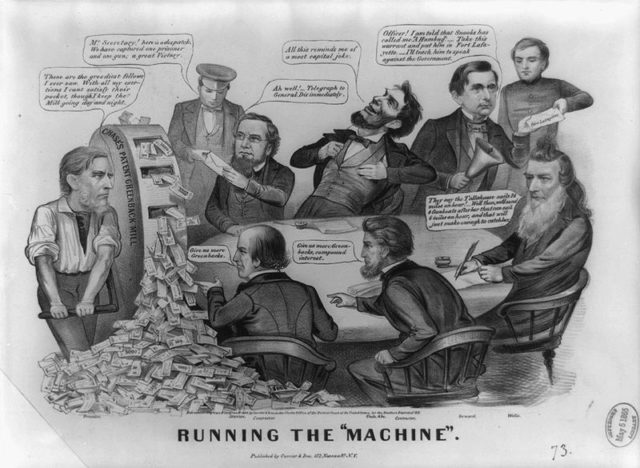
Until the Civil War, no one in the United States paid income tax. Unfortunately, when in 1861, it was found that the Union would need $320 million for just one year of war, the Secretary of the Treasury, Samuel P. Chase, said that he could raise the first $3 million, but that Congress needed to find the other twenty.
Congress’s passed a 3% tax on incomes over $800 but didn’t put it into action. A year later, Lincoln signed a 3% tax on incomes between $600 and $10,000 and 5% on incomes above that. In 1864, those were raised to 5% and 7.5%.
Meanwhile, the Confederacy imposed an income tax that exempted any income up to $1000, taxed 1% of incomes reaching $1500 and 2% on additional income over $1500.
The Union’s Federal income tax continued until 1872 when it was repealed as unconstitutional. Too bad that didn’t stick . . .
6. Aerial surveillance
Before the Civil War, the French had made use of hot air balloons for military purposes. However, it was not on a large scale and they were not used as ingeniously or effectively as in the Civil War.
Professor Thaddeus S.C. Lowe established the Union Army Balloon Corps under orders from President Lincoln in 1861. After trial and error with different fueling methods, he ended up with seven balloons that were deemed fit for service.
Lowe’s balloons were the first to be used in aerial reconnaissance for the purpose of making maps of the battlefields.
The Union Army Balloon Corps was also the first military to use flag signals from the air to help soldiers fire blind at unseen targets.
While it’s a little tongue in cheek, the barge that transported one of Lowe’s balloons down the Potomac is known as the U.S. military’s first aircraft carrier.
5. Standard shoe sizing
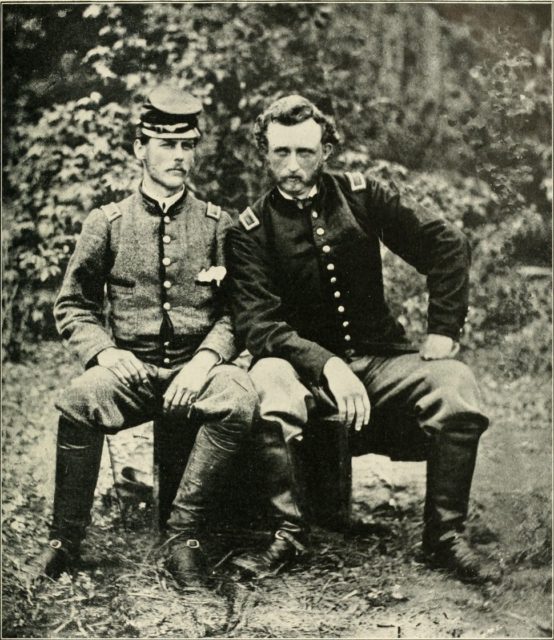
This one may or may not be a myth. It states that because most shoes were cobbled specifically for the wearer that when the army had to mass produce shoes for the war, they came up with standard sizes for the first time.
Another possible myth is that shoes before the war were the same on each foot but that it was noted that the soldiers might fare better in marches if the shoes were better shaped, hence, left and right shoes. The story goes that the Union soldiers then had less foot related injuries from marching than did the Confederates.
While many books and websites make mention of these two innovations, Jefferson Davis himself implemented the combat boots used by the Union Army three years before he became president of the Confederacy. Those boots were in use until the 1880s.
4. Signal Corps
The Union Army was the first military to have a formalized signal corps.
The beginnings of the corps start with Albert James Myer, who had developed a signaling system born out of his own interest in the subject in the 1850s. It wasn’t 1859 that he was able to convince anyone in the military of its usefulness when Robert E. Lee took notice. It would be another four years before the system was implemented.
In May of 1861, Myer’s system was put into use in combat. They system worked by flags during the day and by turpentine torches at night. Signal flags of different colors (red, black, white, and combinations thereof) were used depending upon the background upon which they would be seen, e.g. sky, foliage, etc.
Officers could see the signals from very far away through telescopes. When paired with the Army Balloon Corps, the results of Myer’s efforts were very effective.
3. Limelights
These bright, incandescent lights were already in use in theaters and lighthouses before the war, but General Quincy Adams Gillmore’s brilliant decision to use them in war was a first.
The lights, also known as calcium lights or Drummond lights, used calcium oxide, better known as lime, to create a bright, glowing light. Gillmore shined the blinding beam on the Confederate Fort Wagner in Charleston Harbor, illuminating it while simultaneously veiling by their glow his own men from Confederate sight.
The lights also subverted a Confederate attempt to move up the James River at night. They were planning a sneak attack with ironclad ships but the Union’s limelights exposed them.
2. Dart tailed grenades
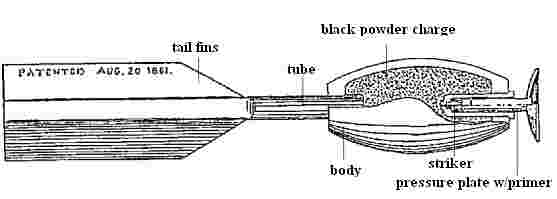
Grenades were nothing new in the 1860s, but both the Union and the Confederacy tried to improve upon them. Both the Ketchum Grenade and the Raines Grenade used dart tails to increase speed and accuracy. Though they may have been innovative, they weren’t necessarily always successful.
The Ketchum Grenade’s arrowed dart tail was meant to make the grenade land nose first. If it didn’t, it wouldn’t explode. Once the Confederacy caught on, they became almost a joke. At Port Hudson, the rebel army caught the grenades in blankets and threw them back to the Union side.
1. Jelly beans!
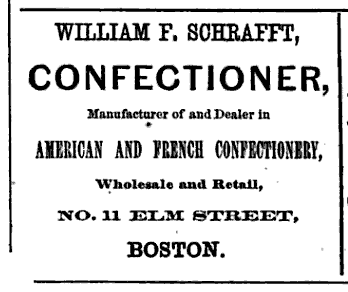
The first known reference to the jelly bean is in an ad by candy purveyor William Schrafft of Boston, Massachusetts.
The candy man thought the jelly bean the ideal candy surprise to send to beloved soldiers away at war.
The jellybean is not mentioned in history again until 1905 in Chicago.
